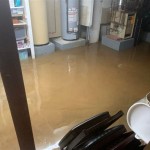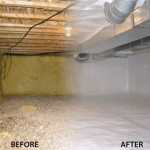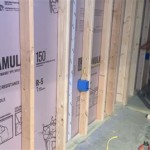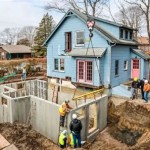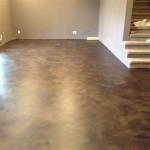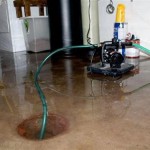How To Seal Block Basement Walls
Sealing block basement walls is a crucial step in maintaining a dry, healthy, and structurally sound home. Concrete blocks, while durable, are porous and susceptible to moisture penetration. This moisture can lead to a range of problems, including mold growth, efflorescence, damage to stored items, and even structural damage to the foundation itself. Properly sealing these walls prevents water from entering the basement, mitigating these risks and creating a more comfortable and usable living space.
The process of sealing block basement walls involves several key steps, from identifying the sources of moisture to preparing the surfaces and applying the appropriate sealant. Choosing the right sealant and applying it correctly are essential for achieving long-lasting protection. This article will outline the necessary steps and provide guidance on how to effectively seal block basement walls.
Identifying the Source of Moisture and Assessing the Problem
Before embarking on any sealing project, understanding the source of moisture is paramount. Water can enter a basement through various pathways, including cracks in the foundation, porous concrete blocks, inadequate drainage around the foundation, and condensation. Identifying the primary source of the problem informs the choice of sealing method and ensures that the solution addresses the root cause.
A thorough inspection of the basement walls, floor, and surrounding area is necessary. Look for visible signs of water intrusion, such as water stains, dampness, mold growth, and efflorescence (a white, powdery deposit that forms on the surface of concrete or masonry as water evaporates). The presence of efflorescence indicates that water is passing through the block walls, carrying dissolved salts to the surface as it evaporates.
Examine the exterior of the foundation for cracks or other damage. Check the grading around the house to ensure that water flows away from the foundation. Inspect the gutters and downspouts to make sure they are functioning properly and directing water away from the house. Poor drainage can lead to water pooling around the foundation, increasing the likelihood of water penetration.
Consider the possibility of hydrostatic pressure. This pressure results from the weight of water in the soil surrounding the foundation. When the soil is saturated, the water pressure can force water through even small cracks or pores in the block walls. Addressing hydrostatic pressure typically involves improving drainage around the foundation and potentially installing an interior drainage system.
Once the source of moisture is identified, the extent of the problem needs to be assessed. This involves determining the amount of water that is entering the basement and the area that is affected. This assessment helps determine the amount of sealant needed and the scope of the preparation work required.
Preparing the Block Walls for Sealing
Proper preparation of the block walls is crucial for the successful application of any sealant. A clean, sound surface ensures that the sealant adheres properly and provides a durable, long-lasting barrier against moisture. Failure to prepare the walls adequately can lead to premature failure of the sealant and continued water intrusion.
The first step in preparing the walls is to remove any loose or crumbling material. This can be accomplished using a wire brush, scraper, or even a power washer. Pay particular attention to areas where there is efflorescence or mold growth. Efflorescence must be removed completely, as it can interfere with the adhesion of the sealant. Mold growth should be treated with a mold-killing solution to prevent it from returning.
Next, clean the walls thoroughly to remove any dirt, dust, or debris. This can be done using a stiff brush and a solution of water and detergent. Rinse the walls thoroughly to remove any soap residue. Allow the walls to dry completely before proceeding to the next step. A dehumidifier can be used to speed up the drying process.
Inspect the walls for cracks or holes. Small cracks can be filled with a concrete patching compound or hydraulic cement. Hydraulic cement is a fast-setting cement that expands as it cures, creating a watertight seal. Larger cracks or holes may require more extensive repairs, such as patching with mortar or concrete. Allow the patching material to cure completely before applying the sealant.
Consider applying a concrete primer before applying the sealant. A primer can improve the adhesion of the sealant and help to seal any remaining pores in the block walls. Choose a primer that is compatible with the sealant that will be used. Apply the primer according to the manufacturer's instructions. Allow the primer to dry completely before proceeding to the sealing stage.
Choosing and Applying the Right Sealant
Selecting the appropriate sealant is critical to the success of the project. There are several different types of sealants available, each with its own advantages and disadvantages. The choice of sealant depends on the specific conditions of the basement, the type of block walls, and the desired level of protection.
One popular option is a masonry sealant. These sealants are specifically designed for use on concrete and masonry surfaces. They are typically made from acrylic or silicone and are available in a variety of colors. Masonry sealants are relatively easy to apply and provide a good level of protection against moisture.
Another option is a cementitious coating. These coatings are made from a mixture of cement, sand, and other additives. They are applied in multiple coats and create a thick, durable barrier against moisture. Cementitious coatings are more labor-intensive to apply than masonry sealants, but they offer superior protection.
Epoxy coatings are also used for sealing block basement walls. Epoxy coatings are two-part systems that are mixed together before application. They create a very hard, durable, and waterproof barrier. Epoxy coatings are more expensive than masonry sealants or cementitious coatings, but they are a good choice for basements that are subject to high levels of moisture.
Before applying any sealant, read the manufacturer's instructions carefully. Follow the instructions regarding surface preparation, application methods, and drying times. Use the recommended application tools, such as brushes, rollers, or sprayers. Apply the sealant in a uniform layer, ensuring that all surfaces are covered completely. Pay particular attention to corners and edges, as these are common areas for water to penetrate.
Apply multiple coats of sealant, following the manufacturer's recommendations. Multiple coats provide a thicker, more durable barrier against moisture. Allow each coat to dry completely before applying the next coat. Maintain proper ventilation during and after application to allow the sealant to dry properly. Avoid applying sealant in direct sunlight or in extreme temperatures, as this can affect the drying time and adhesion.
After the sealant has been applied and allowed to dry completely, inspect the walls for any missed spots or areas where the sealant is thin. Touch up these areas with additional sealant as needed. Ensure that the entire surface is covered completely and that there are no gaps or cracks in the sealant layer.
Consider installing a vapor barrier on the interior side of the sealed block walls. A vapor barrier helps to prevent moisture from condensing on the cold surface of the walls. Install the vapor barrier according to the manufacturer's instructions. Overlap the seams of the vapor barrier to create a continuous barrier against moisture.
After sealing the block basement walls, address any drainage issues around the foundation. Ensure that the grading slopes away from the house and that gutters and downspouts are functioning properly. Consider installing a French drain or other drainage system to improve drainage around the foundation.
Regularly inspect the sealed block basement walls for any signs of water intrusion. Address any problems promptly to prevent further damage. Reapply sealant as needed to maintain a continuous barrier against moisture.
By following these steps, homeowners can effectively seal block basement walls and prevent water from entering the basement. This will help to create a drier, healthier, and more comfortable living space and protect the foundation from damage.

11 Concrete Block Waterproofing Tips Polyguard Residential

Waterproofing Basement Walls Dos And Don Ts To Remember Bob Vila

How To Waterproof Basement Walls With Flex Seal Products Youtube

The Wallcap System For Block Foundation Wall Sealing

Waterproofing A Basement And Getting Rid Of Mold Mildew Is No Easy Feat

Ames Block And Wall 1 Gal Liquid Rubber Waterproof Sealant Bwrf1 The Home

Guide To Waterproofing Basement Walls

Sealing Basement Walls And Floors Hgtv

Block Foundation Waterproofing Watertite

Do It Yourself Basement Waterproofing Finishing Walls Inspiration

